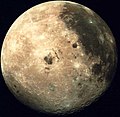English: This color image of the Moon was taken by the
Galileo spacecraft on Dec. 9, 1990, at 9:35 a.m. PST, at a range of about 560,000 kilometres (350,000 mi). The color composite uses monochrome images taken through violet, red, and near-infrared filters. The concentric, circular Orientale basin, 970 kilometres (600 mi) across, is near the center; the near side is to the right, the far side to the left. At the upper right is the large, dark
Oceanus Procellarum; below it is the smaller
Mare Humorum. These, like the small dark
Mare Orientale in the center of the basin, formed over 3 billion years ago as basaltic lava flows. At the lower left, among the southern cratered highlands of the far side, is the
South Pole–Aitken basin, similar to Orientale but twice as great in diameter and much older and more degraded by cratering and weathering. The cratered highlands of the near and far sides and the Maria are covered with scattered bright, young ray craters.
Deutsch: Diese Farbaufnahme des Mondes wurde am 9. Dezember 1990 um 21.35 Uhr von der
Raumsonde Galileo aus einer Entfernung von ca. 560,000 km (350,000 mi) aufgenommen. Das Bild wurde aus monochromen Einzelaufnahmen mit jeweils vorgeschalteten Violett-, Rot-, und Infrarot-Filtern zusammengefügt. In der Mitte des Bildes ist das ca. 970 km (600 mi) durchmessende, kreisrunde
Mare Orientale (Östliches Meer) zu sehen, wobei sich das der Erde nähere Ende auf der rechten Seite und das der Erde weiter entfernte Ende auf der linken Seite befindet. Am oberen rechten Ende befindet sich der dunkle
Oceanus Procellarum (Ozean der Stürme), darunter das
Mare Humorum (Meer der Feuchtigkeit). Diese wurden, so wie auch das kleine Mare Orientalis, vor etwa 3 Milliarden Jahren durch fließende Lava gebildet. Auf der unteren linken Seite, inmitten der südlichen, von
Kratern übersäten Hochebenen der Mondrückseite ist das am Südpol befindliche
Aitken-Bassin zu finden, das ähnlich zum Mare Orientale, jedoch etwa doppelt so groß im Durchmesser, wesentlich älter und abgeflachter durch Meteroiteneinschläge und andere Einflüsse ist. Die von Kratern übersäten Hochebenen und die Meere sind überdeckt mit klaren, neuen Kratern.






